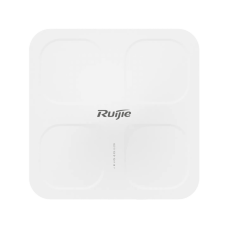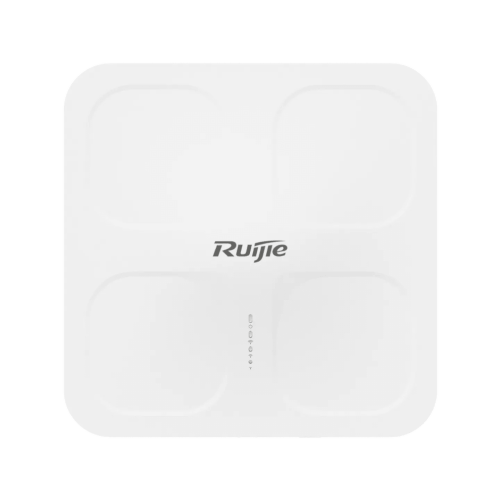RG-AP680P-L, Wi-Fi 6 Dual-Radio 5.951 Gbps Outdoor Access Point, Omnidirectional Antennas Best Price In Dubai, UAE.
Availability:
In Stock
Outdoor scenarios in general education, SME, energy, business, government, and healthcare sectors
Highlight Features
- 10G optical port for flexible networking
- Built-in omnidirectional antennas, wide Wi-Fi coverage
- 5.951 Gbps high speed with 160 MHz band
- Industrial-grade product design, IP68 rating, 6 kV lightning protection
- Ruijie cloud management, intelligent optimization
Description
Key Specification
Product Overview
The RG-AP680P-L is an 802.11ax-compliant dual-radio wireless access point (AP) provided by Ruijie Networks and is fit for higher education, wireless city, energy, and plaza scenarios. It complies with 802.11ax, 802.11ac Wave2, 802.11ac Wave1, and 802.11n. With a hardware-independent dual-radio design, the RG-AP680P-L can provide a data rate of up to 5.951 Gbps. The ultra-fast wireless rate eliminates the performance bottleneck.
The design of the RG-AP680P-L considers factors such as wireless network security, radio control, mobile access, QoS, seamless roaming, and Internet of Things (IoT) scalability. With Ruijie's access controller (AC) and Ruijie Cloud servers, the RG-AP680P-L can implement wireless client data forwarding, security features, access control, and IoT application extension. The RG-AP680P-L adopts IP68 rated housing. It is applicable to harsh outdoor environments and easy to install and maintain.
Product Highlights
Wi-Fi 6 certification
Data rate of up to 5.951 Gbps and concurrent dual-radio design
Up to 1024 client connections
Built-in smart omnidirectional antenna
Excellent environmental adaptability: IP68, –40°C to +65°C (–40ºF to +149ºF), and 6 kV surge protection
OFDMA, MU-MIMO technologies for minimal wireless signal interference
Hybrid management: support for thousands of standalone APs, and AC management and public cloud deployment options
Mobile management: free mobile applications for Ruijie Cloud customers
Specifications
Hardware Specifications
| Dimensions and Weight |
RG-AP680P-L |
| Unit dimensions (W x D x H) |
300 mm x 300 mm x 94 mm (11.81 in. x 11.81 in. x 3.70 in.) |
| Shipping dimensions (W x D x H) |
470 mm x 410 mm x 170 mm (18.50 in. x 16.14 in. x 6.69 in.) |
| Unit weight |
Main unit: 3.3 kg (7.28 lbs) Mounting bracket: 1.2 kg (2.65 lbs) |
| Shipping weight |
6.5 kg (14.33 lbs) |
| Mounting |
Wall or pole mounting (a mounting bracket is delivered with the main unit) |
| Wi-Fi Radio |
RG-AP680P-L |
| Radio design |
Dual-radio and eight spatial streams: ● Radio 1: 2.4 GHz, four spatial streams, 4x4 MU-MIMO ● Radio 2: 5 GHz, four spatial streams, 4x4 MU-MIMO |
| Operating frequencies |
Radio 1: 802.11b/g/n/ax ● 2.400 GHz to 2.4835 GHz, channels 1 to 13 Radio 2: 802.11a/n/ac/ax ● 5.150 GHz to 5.250 GHz, U-NII-1, channels 36, 40, 44, and 48 ● 5.250 GHz to 5.350 GHz, U-NII-2A, channels 52, 56, 60, and 64 ● 5.470 GHz to 5.725 GHz, U-NII-2C, channels 100, 104, 108, 112, 116, 120, 124, 128, 132, 136, and 140 ● 5.725 GHz to 5.850 GHz, U-NII-3/ISM, channels 149, 153, 157, 161, and 165 Note: Country-specific restrictions apply. |
| Data rates |
Combined peak data rate: 5.951 Gbps Radio 1: 2.4 GHz, 1.147 Gbps ● Four spatial stream Single User (SU) MIMO for up to 1.147 Gbps wireless data rate to individual 4SS HE40 802.11ax client devices (max.) ● Four spatial stream Single User (SU) MIMO for up to 574 Mbps wireless data rate to individual 4SS HE20 802.11ax client devices (typical) Radio 2: 5 GHz, 4.804 Gbps ● Four spatial stream Single User (SU) MIMO for up to 4.804 Gbps wireless data rate to individual 4SS HE160 802.11ax client devices (max) ● Four spatial stream Single User (SU) MIMO for up to 2.402 Gbps wireless data rate to individual 4SS HE80 802.11ax client devices (typical) ● Four spatial stream Multi-User (MU) MIMO for up to 4.804 Gbps wireless data rate to up to four 1SS HE160 802.11ax DL-MU-MIMO capable client devices simultaneously (max) ● Four spatial stream Multi-User (MU) MIMO for up to 2.402 Gbps wireless data rate to up to four 1SS HE80 802.11ax DL-MU-MIMO capable client devices simultaneously (typical) |
| Data rate set |
The following 802.11-compliant data rates in Mbps are supported: 2.4 GHz radio ● 802.11b: 1, 2, 5.5, 11 ● 802.11g: 1, 2, 5.5, 6, 9, 11, 12, 18, 24, 36, 48, 54 ● 802.11n: 6.5 to 600 (MCS0 to MCS31, HT20 to HT40) ● 802.11ax: 8.6 to 1147 (MCS0 to MCS11, NSS = 1 to 4, HE20 to HE40) 5 GHz radio ● 802.11a: 6, 9, 12, 18, 24, 36, 48, 54 ● 802.11n: 6.5 to 600 (MCS0 to MCS31, HT20 to HT40) ● 802.11ac: 6.5 to 3467 (MCS0 to MCS9, NSS = 1 to 4,VHT20 to VHT160) ● 802.11ax: 8.6 to 4804 (MCS0 to MCS11, NSS = 1 to 4, HE20 to HE160) |
| Packet aggregation |
802.11n/ac/ax : A-MPDU and A-MSDU |
| Antenna type |
Built-in omnidirectional antennas (four 2.4 GHz antennas, four 5 GHz antennas, 1 x Bluetooth antenna, 1 x GPS antenna) |
| Max. antenna gain |
The downtilt angle for the maximum gain is roughly 35 degrees. With reference to the pattern of each antenna of the MIMO radios, the maximum gain of the effective per-antenna pattern is 3 dBi in 2.4 GHz and 3 dBi in 5 GHz. |
| Max. transmit power |
2.4 GHz radio: 30 dBm (24 dBm per chain) 5 GHz radio: 29 dBm (23 dBm per chain) Note: The transmit power is subject to local regulatory requirements. |
| Power increment |
Increment of 1 dBm |
| Radio technologies |
802.11b: Direct-Sequence Spread-Spectrum (DSSS) 802.11a/g/n/ac: Orthogonal Frequency-Division Multiplexing (OFDM) 802.11ax: Orthogonal Frequency Division Multiple Access (OFDMA) |
| Modulation types |
802.11b: BPSK, QPSK, CCK 802.11a/g/n: BPSK, QPSK, 16-QAM, 64-QAM, 256-QAM 802.11ac: BPSK, QPSK, 16-QAM, 64-QAM, 256-QAM, 1024-QAM 802.11ax: BPSK, QPSK, 16-QAM, 64-QAM, 256-QAM, 1024-QAM |
The following table lists the radio frequency performance of Wi-Fi including different frequency bands, protocols, and date rates. It is country-specific, and Ruijie Networks reserves the right of interpretation.
| Wi-Fi Radio Frequency Performance |
RG-AP680P-L |
||
| Frequency Band and Protocol |
Data Rate |
Max. Transmit Power per Transmit Chain |
Max. Receive Sensitivity per Receive Chain |
| 2.4 GHz 802.11b |
1 Mbps |
24 dBm |
–94 dBm |
| 2 Mbps |
24 dBm |
–91 dBm |
|
| 5.5 Mbps |
23 dBm |
–90 dBm |
|
| 11 Mbps |
22 dBm |
–88 dBm |
|
| 2.4 GHz 802.11g |
6 Mbps |
24 dBm |
–89.5 dBm |
| 24 Mbps |
23 dBm |
–83 dBm |
|
| 36 Mbps |
23 dBm |
–79 dBm |
|
| 54 Mbps |
21 dBm |
–73 dBm |
|
| 2.4 GHz 802.11n (HT20) |
MCS0 |
24 dBm |
–86 dBm |
| MCS7 |
21 dBm |
–68 dBm |
|
| 2.4 GHz 802.11n (HT40) |
MCS0 |
24 dBm |
–83 dBm |
| MCS7 |
21 dBm |
–65 dBm |
|
| 2.4 GHz 802.11ax (HE20) |
MCS0 |
24 dBm |
–86 dBm |
| MCS11 |
19 dBm |
–68 dBm |
|
| 2.4 GHz 802.11ax (HE40) |
MCS0 |
24 dBm |
–83 dBm |
| MCS11 |
19 dBm |
–65 dBm |
|
| 5 GHz 802.11a |
6 Mbps |
23 dBm |
–89.5 dBm |
| 24 Mbps |
22 dBm |
–83 dBm |
|
| 36 Mbps |
22 dBm |
–79 dBm |
|
| 54 Mbps |
20 dBm |
–73 dBm |
|
| 5 GHz 802.11n (HT20) |
MCS0 |
23 dBm |
–86 dBm |
| MCS7 |
20 dBm |
–68 dBm |
|
| 5 GHz 802.11n (HT40) |
MCS0 |
23 dBm |
–83 dBm |
| MCS7 |
20 dBm |
–65 dBm |
|
| 5 GHz 802.11ac (VHT20) |
MCS0 |
23dBm |
–86 dBm |
| MCS9 |
19 dBm |
–61 dBm |
|
| 5 GHz 802.11ac (VHT40) |
MCS0 |
23 dBm |
–83 dBm |
| MCS9 |
19 dBm |
–57 dBm |
|
| 5 GHz 802.11ac (VHT80) |
MCS0 |
23 dBm |
–80 dBm |
| MCS9 |
19 dBm |
–53 dBm |
|
| 5 GHz 802.11ax (HE20) |
MCS0 |
23 dBm |
–86 dBm |
| MCS11 |
16 dBm |
–58 dBm |
|
| 5 GHz 802.11ax (HE40) |
MCS0 |
23 dBm |
–83 dBm |
| MCS11 |
16 dBm |
–54 dBm |
|
| 5 GHz 802.11ax (HE80) |
MCS0 |
23 dBm |
–80 dBm |
| MCS11 |
16 dBm |
–52 dBm |
|
| 5 GHz 802.11ax (HE160) |
MCS0 |
23 dBm |
–77 dBm |
| MCS11 |
16 dBm |
–49 dBm |
|






Reviews (0)